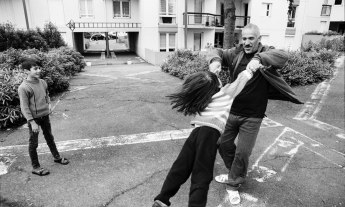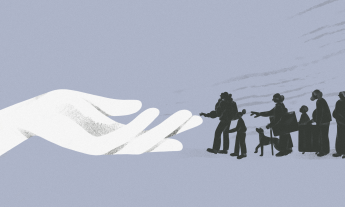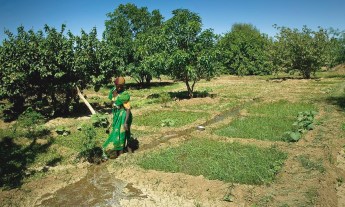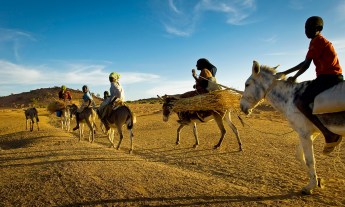Photographer and filmmaker Giles Duley talks about empathy in action.
When Giles Duley arrived in Lebanon to photograph Syrian refugees who’d fled there, he saw something that he wasn’t expecting. He saw himself.
Inside the makeshift city of cardboard and fabric, Duley met many individuals with whom he closely identified. As a triple amputee (Duley was on assignment in Afghanistan in 2011 when he was in a landmine explosion), he felt a close connection with those he met in Lebanon who were coping with disability, coupled with displacement from their homes.
“When I visit these camps, I don’t see refugees,” Duley said. “I see my sisters, my brothers, my nephews, my nieces, my friends — and I think to myself, ‘If the people I love lost everything, would somebody help them?’ These people are in desperate need and it feels like my duty to tell these stories. I just hope people listen and act.”
I don’t want people to walk away and say, “It’s so grim. The world’s doomed.” I want people to walk away and think, “What can I do?”
To make sure that people do, Duley decided to try his hand at making a film, called The Invisible People, to tell these stories in different ways than he could in a photograph. This film ran last week on Channel 4 in the United Kingdom. Watch the film (embedded below), and read an edited transcript of our conversation with Duley.
Invisible People is unique because, while it’s gut-wrenching, it’s also somehow fun to watch. How did you strike that balance?
It’s beyond words how tragic this story is, so you have to have something that lifts it. To me, that’s [the character] Aya. Everyone who’s seen it has said, “I don’t know how, but I felt really uplifted.” Which is good. I don’t want people to walk away and say, “It’s so grim. The world’s doomed.” I want people to walk away and think, “What can I do?”
Aya is a 5-year-old girl with a condition that’s left her paralyzed from the waist down. How did you meet her and her family?
I was introduced to Aya by Handicap International when I was taking photographs in May. When I turned up, she was in a neighbor’s tent on a concrete floor. She was on her own. She looked vulnerable and incredibly scared, and it was a very depressing, upsetting scene — this little girl, paralyzed, on the floor. To be honest, if I took that photograph, it probably would get a lot of praise, because it would be very dramatic. But for me, that’s not the way I like to work. I felt like it was taking advantage of her. It just made her look like a victim. So I put the camera down, and started chatting with the family. After going back a couple of times, I got to see how Aya interacted with them. I got to see that she pretty much runs the family — she is so feisty. I started to see this incredibly strong character.
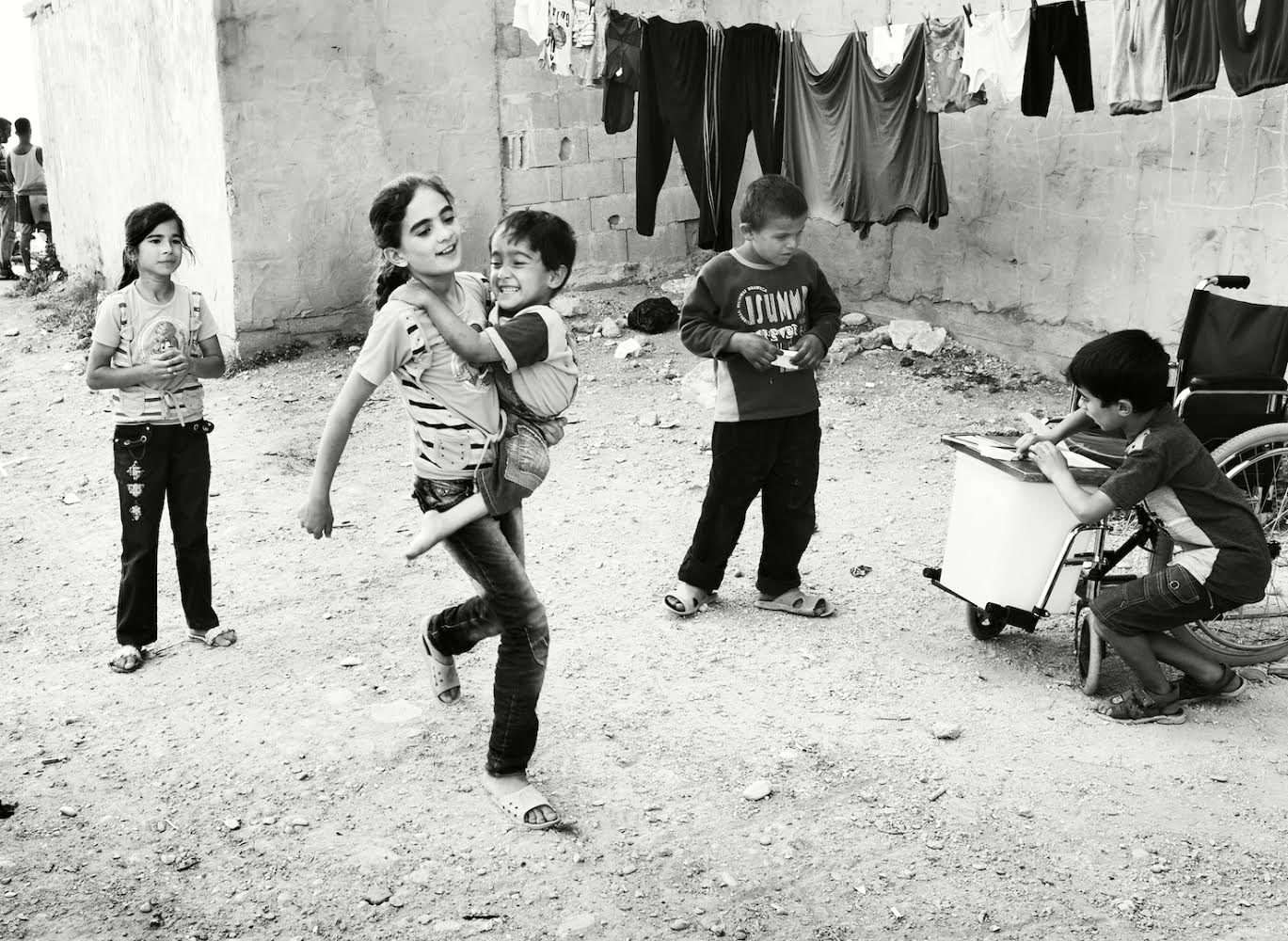
I was talking to her mother about how they got [to Lebanon] from Syria. She said, “I shouldn’t tell you the story; her sister should.” Her 11-year-old sister described how their house was bombed for 10 days and, while they hid in the basement, she held Aya. They had no water, no toilet, no food. She said, “Aya was crying all the time.” She basically carried Aya for two months, being shot at, to get her out of Syria. She said, “Well, I still carry her when we play hopscotch.” So I photographed them playing hopscotch. They’re both laughing, both really enjoying life. That, for me, is the photograph that sums up Aya and her family. You don’t have to photograph somebody in a situation where they look like a victim. It’s pretty obvious that their situation is terrible — you don’t have to explain that. I want to show somebody for who they are, and the life that they have.
You don’t have to photograph somebody in a situation where they look like a victim. show somebody for who they are, and the life that they have.
How did you first get interested in refugee camps? Did the one where Aya’s family lives feel unusual?
I’ve been going to refugee camps for over a decade — I’ve visited camps in Congo, Sudan, Angola and Jordan, so I’m used to seeing them. In May, I went to Lebanon and I was shocked. It felt very different from the other refugee camps I’d seen. Refugee camps are always incredibly depressing places because anybody there, by definition, has lost everything. But I found Lebanon unusual. First, because there were no official refugee camps. The Lebanese won’t allow them, mainly because they built them for the Palestinians, and the Palestinians are still there. They don’t want that to happen again. But I don’t think they expected the sheer numbers of people who came this time. They’ve got 1.5 million refugees. Some have found private places to rent — garages, unfinished buildings. Others are forced to squat on land and build tents.
Normally in a refugee camp, you have schools being built, hospitals and other infrastructure. But these refugees had no access to schools, no access to healthcare. What I really noticed was people lacking hope. In refugee camps, when you talk to people, they have hope — about going home, about building a new life. But the people I met in Lebanon seemed to have no hope. The war in Syria’s been going on for years. They know they can’t get their kids into a school, and they have no idea what would happen if someone in the family got ill. When you take hope from people … that’s really the last thing.
Seeing people without hope really, really upset me. I wanted to do more about it. So I persuaded Channel 4 to make a film with me about it. I kept knocking on doors and heard time and time again: “People are not interested in stories about refugees. No one’s going to watch a documentary on it.” Yes, if you have a choice between a story on Kim Kardashian and refugees, most people would probably check out the Kim Kardashian thing. But that doesn’t mean these films shouldn’t be made. These stories are vital. You just have to find ways to get people to watch. I was lucky to work with a director named David Fuller. He got it and helped write the script with me.
It was an interesting decision to focus on specific people and families so that you really get to know them. How did you decide to focus this film that way?
When you talk about 3 million displaced from Syria, and the 1.5 million of them in Lebanon, people go, “Ugh! I can’t cope with it.” But for me, it’s always about the individuals, and about the families. When you can get people to relate to those families — when you show the love between a brother and sister, when you show parents worrying about their kids — people suddenly start to get it. It’s those day-to-day, everyday occurrences that actually make people think. That’s why I wanted to focus on a few families, so that people would engage with them, and see how they’re just like a normal family.
When you talk about 3 million displaced from Syria, and the 1.5 million of them in Lebanon, people go, “Ugh! I can’t cope with it.” But for me, it’s always about the individuals, and about the families.
I bonded with Aya and her family. I wanted to go back and tell their story. People say to me, “What’s it like when you get to a refugee camp? It must be very intimidating.” But the last time I went to the unofficial refugee camp where Aya’s family lives, people came over to me and the first comment was, “Have you lost some weight Giles? You look good!” They want to know what diet I’ve been on; people are asking me about football games. “Barcelona or Real Madrid, who do you think is gonna win?”
People are not refugees. People are taxi drivers, they’re mechanics, they’re lawyers, they’re doctors, they’re nurses, they’re parents, they’re grandparents, they’re children. They’ve become refugees. It’s so important to me that people see them as people. Just like us.
By concentrating on one family, you make people understand all the refugees there. You show how imperiled they are. With Aya, it’s a possibility that she won’t survive the winter. She’s never lived through a winter like that with below freezing temperatures. In the past, her family never allowed her out of the house during the winter.
How much communication do you have with her family now? Have they found better shelter?
I speak with them once a week. The good thing is that the film’s brought attention to their case and the UNHCR is trying to rehouse them. I’m hoping we can find some hope for them.
As soon as you classify them as refugees, it’s like they’re not people anymore. In reality, they are exactly the same as any of us.
But it’s important to remember that roughly 20% of the refugees have a disability of some sort because so many people have been injured in the conflict. You imagine what it’s like for them, and for their families. I was a care worker for a couple of years, and I know that it’s the most draining, exhausting job you can possibly imagine. The idea of doing that in a refugee camp — where you’ve got no running water, no medical support, no network around you — is beyond my comprehension.
What do people not understand about the Syrian refugee experience that you want to make sure they know?
That as soon as you classify them as refugees, it’s like they’re not people anymore. In reality, they are exactly the same as any of us in terms of their hopes and dreams. They wake up and worry, ‘What if my children don’t get an education? What happens to their future?’ They have fear about their grandparents, too. If they were getting cancer treatment in Syria — or chemotherapy, or were on dialysis — they’re not getting that anymore.
What kinds of predictions do they make for the future?
I’ve seen a change over the years. At first, people didn’t think the war would go on long. But now, people just don’t know. Nobody looking for a political solution. There are no peace conferences; there’s no end in sight. The country is so destroyed. You see pictures of Aleppo and it looks like Stalingrad. People know that, even if they go back, it’s not going to be the country it was. Some of the children haven’t been to school for four years now. These are the kids that are expected to rebuild their country — and yet many are 16 or 17 and haven’t been to school since they were 12. A lot of the charities talk about the idea of a “lost generation.” There really will be a whole generation of kids that haven’t been educated, that only know war. What kind of country will that build?
Aid workers are the unsung heroes of these crises.
At one point in the film, someone mentions frontline workers and how hard it is for them to not be able to offer more resources to the Syrians in Lebanon.
I’m good friends with a lot of the charity workers. I think they’re incredible. I wish we could have made the film longer to tell more of their stories. Within Handicap International, there a lot of physiotherapists and social workers working with the refugees. They are Lebanese — they’re career driven, they want to make a difference, they work ridiculous hours, they’re exhausted. They’ve been doing this for years now, and the funding is constantly being cut because most charities have only received a fraction of what they need to keep running in this crisis. Rather than expanding when the refugee numbers are increasing, most charities are actually having to cut down, which is putting more strain on the workers.
My respect for aid workers — both those from the countries and the international staff — it’s beyond respect. I go to these places for a few weeks or a couple of months. These people are based there and are working for years for very little pay and very little credit. But they make such a difference. They are the unsung heroes of these crises.
This is a crisis that affects the whole world.
For people in other parts of the world, what can we do to make sure resources are available?
Just have awareness of what the situation is on the ground. The majority of people affected by [the crisis in Syria] are civilians who only want peace. While we flex our military muscles, we also need to also kind of flex our humanitarian muscles because these people are more affected by ISIS and by Bashar al-Assad than the West is. It’s easy for people to think, “Why should I care about Syrian refugees in Lebanon?” This is a crisis that affects the whole world. Lebanon’s at real risk of being destabilized. 25% of the population is now made up of refugees; there’s a growing disquiet among people in the country. If we don’t support refugees, it could destabilize the region even further and we’ll all feel those consequences. There’s a humanitarian reason for supporting refugees: these people are suffering. But there is a security reason also: we need to help stabilize that country.
If someone wanted to donate, what are good organizations to do it through?
Handicap International is the only charity focused on people with disabilities. War Child is also great, as well as Save the Children. I know a lot of people get cynical about giving money. But there are only a few charities I work with and I’m very aware of how much their resources go to people that need it. I focus on work with NGOs that I really see having an impact.








